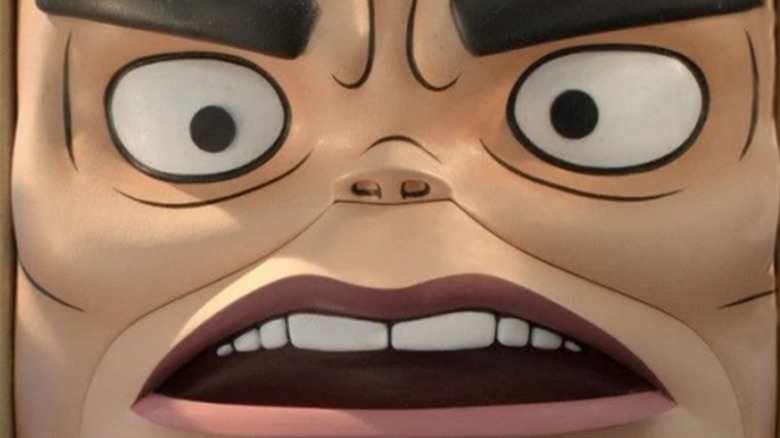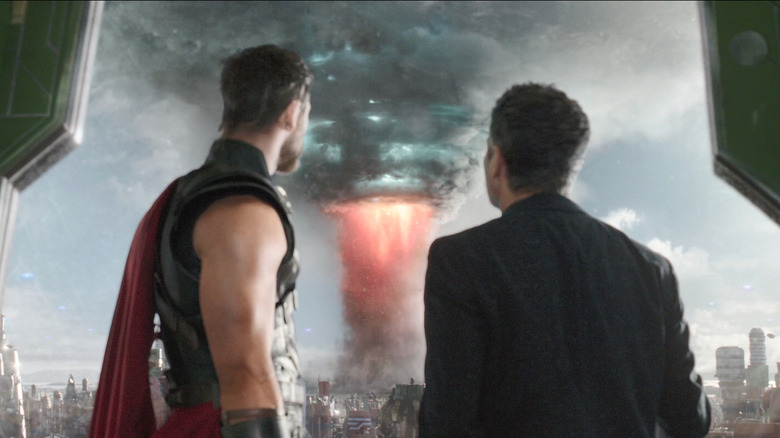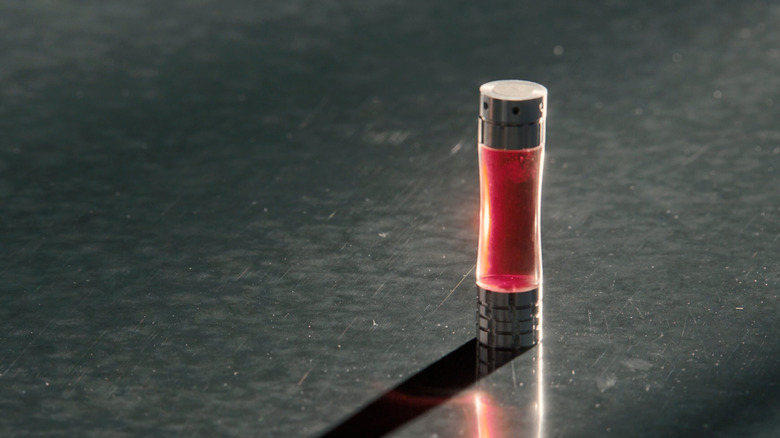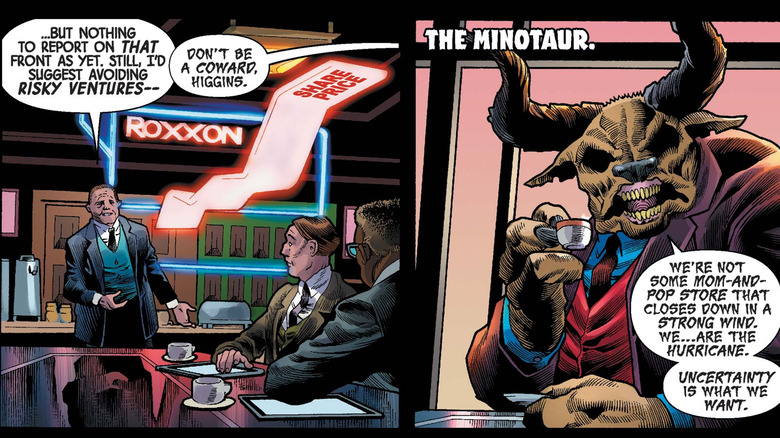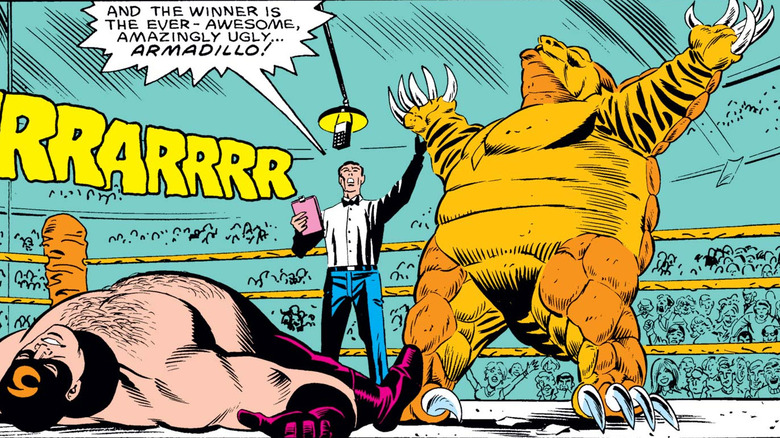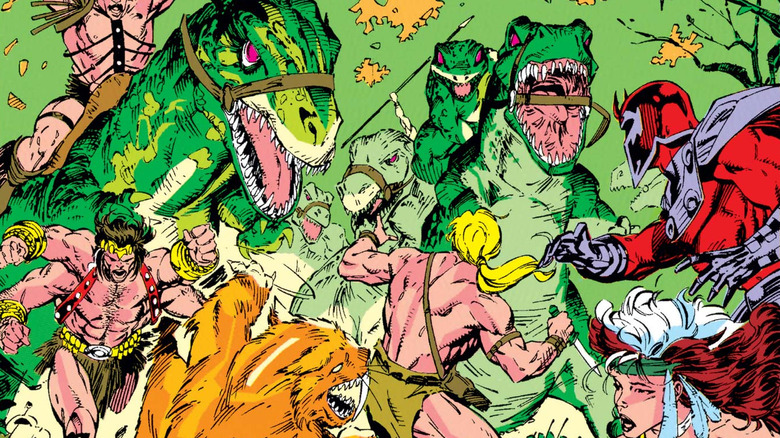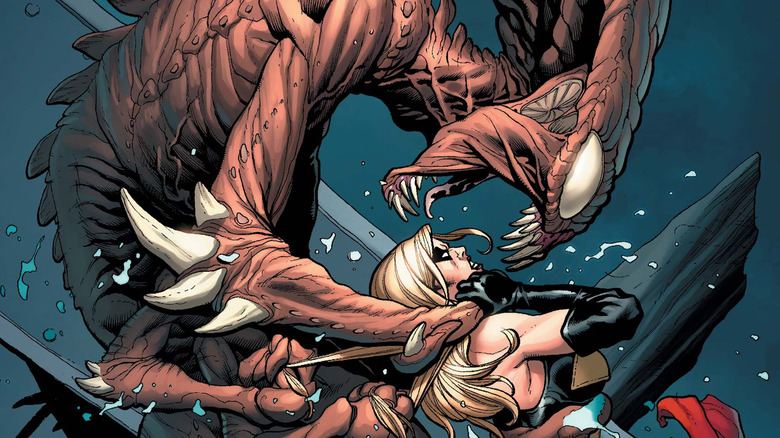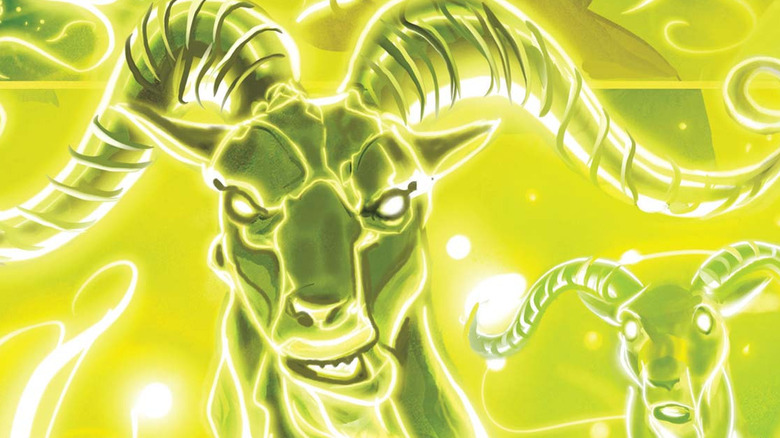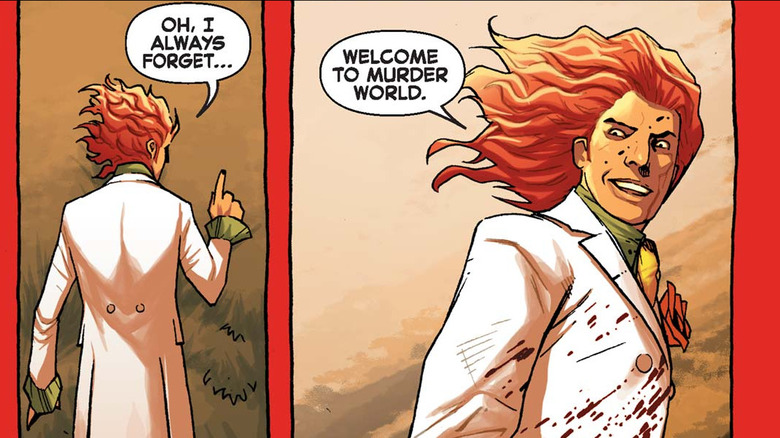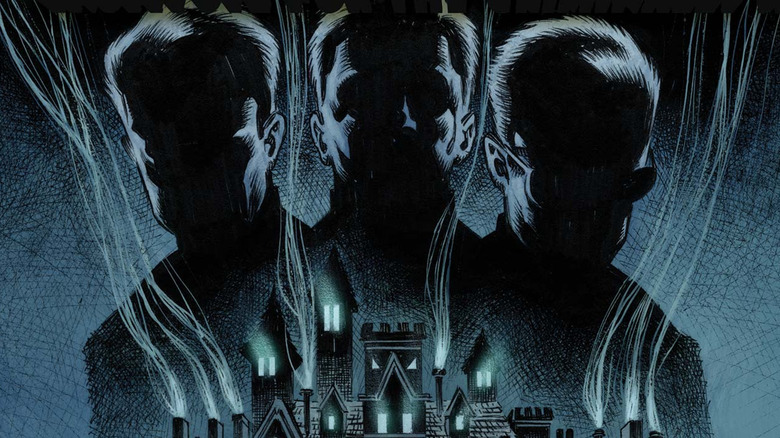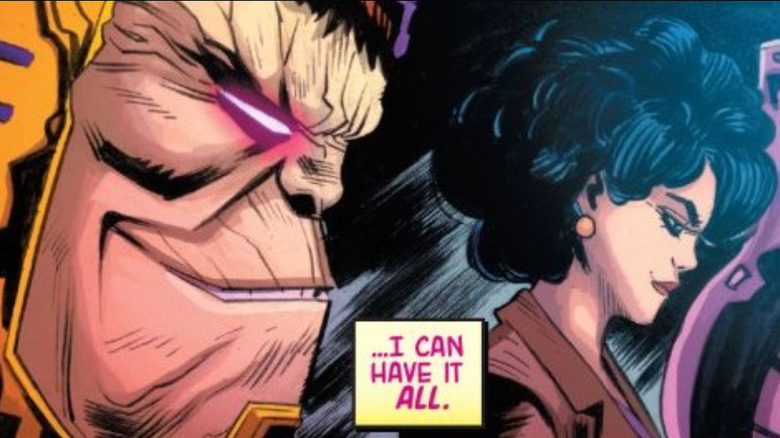Lines In MODOK That Mean More Than You Realize
Don't look now, but there's a new Marvel Studios show, which can mean only one thing: It's time to dissect it, taking it apart piece by piece in search of hidden references, easter eggs, and clues to what the future of the MCU might hold.
The first place fans tend to search for such things is, naturally, the script. Of course, Hulu's "MODOK." isn't your typical Marvel Comics adaptation — a stop motion animated comedy from the demented minds behind "Robot Chicken" and "American Dad!" that recasts one of Marvel's weirdest and deadliest villains (voiced with comedic precision by Patton Oswalt) as a bumbling, life-crumbling family man.
It isn't faithful to the source material by a long shot, and it doesn't appear to connect directly to the Marvel Cinematic Universe (or any other Marvel television property, for that matter). Does this mean its episodes don't contain dialogue with obscure references that only die-hard comic book or MCU fans could comprehend without assistance? Quite the opposite! "MODOK" is filled to the brim with Marvel references, including numerous lines that mean far more than you might think. Our task here is to shine a light on those lines, revealing the secrets contained within.
As a warning, this list contains spoilers for the entirety of the "MODOK" series. So, if you haven't see the show yet, turn your hoverchair around now! Once these secrets are spoiled, not even MODOK'S time machine — which he dented, not invented, btw — can help you.
Rosen and Einstein are dead
Most of the meaningful lines from "MODOK" are references to Marvel Comics, but the first one we're going to talk about is more familiar to fans of the MCU — or more precisely, real-life theoretical physics.
After MODOK's battle with Iron Man (Jon Hamm) kicks off the first episode, the show reveals one part of its central premise: His company, Advanced Idea Mechanics, is broke. Eventually this leads to its purchase by the parody tech company GRUMBL, but prior to going that route, MODOK still has a few ideas to keep the lights on. "I have a very simple plan to save AIM," he tells his minions. "We are going rob Fort Knox by opening an Einstein–Rosen bridge into.." At this point, naturally, the building's power is cut off.
The phrase "Einstein-Rosen bridge" should be familiar to anyone who's seen the "Thor" movies, as it is frequently referenced in connection with wormholes — passages connecting two different points of spacetime, allowing instantaneous travel between them. In fact, it's very much a real theory — the Einstein and Rosen in question are Albert Einstein and his collaborator, Nathan Rosen, who initially posited the idea of wormholes. Presumably, Marvel Studios thought (not incorrectly) that the word "wormhole" was a little overplayed in science fiction, and decided to use the more scientific-sounding term, with the result that "Einstein-Rosen bridge" is now irreversibly associated with the MCU.
New and Pym-proved
While we're on the subject of scientific MacGuffins from the MCU, the first episode of "MODOK" also includes a reference to Pym Particles — the invention that drives the entire technological premise of the "Ant-Man" franchise, and that the Avengers use to enter the quantum realm and facilitate the time heist in "Avengers: Endgame."
Seeking a way to prevent GRUMBL CEO Austin Van Der Sleet (an impressively obnoxious Beck Bennett) from officially signing off on the merger between GRUMBL and AIM, MODOK decides to shrink himself and take control of Austin's brain from the inside (a "mind heist," as he puts it). How will he accomplish this? "I, MODOK, reverse-engineered Pym Particles and then improved their design by making them chewables!"
Pym Particles do exist in the comics, of course, but this is pretty clearly an MCU pull. It's also an important early indicator that MODOK actually does know what he's doing, from a science perspective, at least — it's pretty impressive that he was able to reverse-engineer Hank Pym's signature invention, and a chewable product that allows people to change size actually sounds like it could make a few bucks.
Roxxon, Roxxoff
Another central conflict introduced in Episode 1 is the conflict between MODOK and his wife, Jodie (Aimee Garcia), who ends the first episode by asking for a divorce.
This is prompted primarily by MODOK's obsession with AIM and dismissal of Jodie's own career, which comes to a head when he ruins an interview between Jodie and Austin. This, however, doesn't derail Jodie's plans — while having dinner with MODOK, who again dismisses her career, she proclaims "I ended up signing with Roxxon as a lifestyle influencer, I will have you know!"
The name Roxxon should be familiar to MCU fans and Marvel Comics fans alike. While it's never been a major plot point in any Marvel Studios adaptation, Roxxon has appeared or been mentioned in all three "Iron Man" films, as well as previous Marvel television shows like "Daredevil," "Agent Carter," "Agents of S.H.I.E.L.D.," "Cloak and Dagger," and "Runaways." In the comics, it is a ruthless energy corporation that has gone up against the likes of Captain America, Iron Man, Spider-Man, the X-Men, and Thor. More recently, Roxxon and its CEO, an actual minotaur named Dario Agger, became the target of the Hulk in Al Ewing's "Immortal Hulk" series. As we see later in "MODOK," Jodie isn't exactly a pinnacle of moral strength when it comes to her career, but even so, she might want to reconsider working for such a brazenly villainous organization.
The pain of being Armadillo
The fourth episode of "MODOK" introduces a number of side characters that MODOK recruits to help him steal Captain America's shield. All of them are taken from Marvel Comics, but for the most part, their portrayal here doesn't take much inspiration from their four-color origins. The only member of this crew with a story that even vaguely resembles the comics is Armadillo (Dustin Ybarra), who freaks out during their visit to a pawn shop, saying "Why do you have my wife's ring? I thought we were working it out!"
In the comics, Antonio Rodriguez voluntarily underwent an experiment by Dr. Karlin Malus that fused his DNA with that of an armadillo in exchange for Malus' help curing Rodriguez' wife, Bonita, of an unknown disease. Malus ultimately did so, but the marriage didn't last; Armadillo later discovered that Bonita was cheating on him and went on a destructive rampage that ended with an unsuccessful suicide attempt. While Mandrill was, to the best of our knowledge, not involved in the affair, Armadillo's brief, delusional attempt to save his long-demolished marriage in "MODOK" is a direct callback to his origin story.
Savage land, savage golf
While attending the GRUMBL conference in Episode 3, MODOK's daughter Melissa (Melissa Fumero) teaches him how to psychologically manipulate the people around him, leading to a sequence in which he uses the insecurities of three GRUMBL executives to undercut their confidence during a round of golf (or rather, a variation of golf that involves horses, and occasionally catapults). By the end of this sequence, MODOK has all three wrapped around his finger. We know this, in part, due to their reactions to a joke he's telling, the punchline of which is "They were playing horseless golf! Are we cavemen? Am I in the Savage Land right now?"
"M.O.D.O.K." viewers unfamiliar with Marvel Comics might not realize that the Savage Land MODOK is referring to is a specific location within the Marvel universe.
Somewhere in Antarctica is a hidden pocket of prehistoric jungle, created and maintained by ancient alien technology, populated by dinosaurs, animal/human hybrids, and primitive tribes. While the Savage Land was originally conceived back in 1941 and is the home of characters like Ka-Zar and Shanna the She-Devil, it is widely associated with "X-Men," the comic that gave it its name and most of its signature elements. It's one of a few "X-Men" references tossed around by "MODOK" — the most obvious being the appearance of Mr. Sinister — as Marvel slowly starts integrating "X-Men" properties into its television and (eventually) film projects.
Brood for thought
Speaking of "X-Men" references in Episode 3, another big one pops up at the GRUMBL conference party later on, after MODOK gets bored with following Melissa's advice and decides to take a shortcut to office popularity by secretly warping in an alien monster and taking credit for defeating it.
After considering the Skrulls, the Shi'ar, and the Watchers, he ultimately finds an extraterrestrial species that works for him. "The Brood! Crazy scary, scary crazy," he says. "And, susceptible to my mind blasts!"
Of course, the Brood turn out to have been recently partied to death by another alien race, the hedonistic Ciegrimites — whose comic book origins see them hailing from a planet with 7% alcohol content in the atmosphere — but their inclusion is another example of Marvel Studios slowly dipping their toe into the waters of "X-Men"-related intellectual property. After all, the Brood were created by legendary "X-Men" writer Chris Claremont and first appeared in the pages of "Uncanny X-Men" in 1982. A parasitic, insectoid hive mind that lays eggs in the bodies of other creatures to assimilate them, they are far more "crazy scary" than they appear in "MODOK," and we feel for any superhero unlucky enough to be the first to encounter them on the big screen.
When goats fly
The 6th episode of "MODOK," entitled "Tales from the Great Bar-Mitzvah War," takes place in Asgard, giving the show plenty of opportunities to poke fun at the Marvel Comics' version of the home of the Norse gods. It also confirms (for anyone who required confirmation) that "MODOK" does not take place in the current incarnation of the MCU, in which Asgard has been destroyed.
One of the best Asgard-adjacent jokes involves the hover chair of MODOK being disabled by a goat, immobilizing him until he notices a flying chariot being pulled by a pair of goats and triumphantly realizes that "in Asgard, goats can fly!"
While it seems that in this Asgard, most goats can indeed fly (though naturally not the ones MODOK chooses to harness), this is specifically a reference to Thor's goats, Toothgnasher and Toothgrinder, who are able to pull his flying chariot due to their particular mystical nature. Up to this point their appearances have been limited to the comics, but recent set photos from the upcoming "Thor: Love and Thunder" suggest we might be seeing them in the MCU very soon.
Welcome to Murderworld
The central antagonists of "MODOK" include Austin, Hexus the Living Corporation, and a dimension-hopping alternate version of MODOK himself known as the Anomaly. In Episode 8, however, the Tarleton family is terrorized by a new nemesis, a red-head with a bowtie who calls himself Arcade. An assassin whose weapon of choice is the overly-elaborate deathtrap, he's been hired by the Anomaly to create just such a deathtrap for the Tarletons, and when they stand before him, the Anomaly proudly proclaims, "Arcade and I would like to welcome you ... to Murderworld!"
For fans of Marvel Comics, "Welcome to Murderworld" is an extremely loaded phrase, being Arcade's signature opening line when his latest superheroic victim wakes up in one of his homicidal games.
The name "Murderworld" generally refers to the technological amusement parks that Arcade crafts and stocks with weapons and puzzles. There have been several Murderworlds — the first and most famous was in Manhattan, with other variations including Murder Island and the Wonderland-themed Doorway to Destiny.
The most notable variant is the Antarctic Murderworld from 2012's "Avengers Arena," aka the story that finally takes Arcade seriously. So far, "MODOK" seems more interested in lambasting the supervillain's tendency towards self-sabotaging lunacy — hence the pinball jokes — but nobody who's read "Avengers Arena" can hear the phrase "Welcome to Murderworld" without a chill running down their spine.
You've got the job, JANUS
Despite the show's large quantity of villains, Anomaly eventually proves to be the big bad of "MODOK" Season 1, driving the action in the season finale after MODOK's defeat of secondary villain Hexus in Episode 9. Hexus, however, isn't completely gone — Episode 9 ends with the Living Corporation swearing vengeance on MODOK, a goal it intends to accomplish thanks to its newly-hired CEO. "And now, with Janice by our side, Hexus will stop at nothing to destroy MODOK!" it proclaims.
On the surface, this just seems like a throwaway joke. "Janice" appears to be a normal human woman who just happened to apply for the CEO job, responds to the standard interview question of "what is your biggest weakness" with the stock answer of "I work too hard," and is immediately hired. Funny joke, everybody laugh, roll credits ... except there could be way more going on here.
We're assuming that normal human Janice spells her name the normal human way, but her name could also be a reference to JANUS, a secretive organization introduced in Marvel Comics in November 2020, whose membership happens to include "MODOK" regular Monica Rappaccini (Wendi McLendon-Covey). The show has already featured tie-ins to current Marvel comics, and it can't be denied that, while Hexus as a character originates in an obscure issue of "Marvel Boy," the show's version bears a striking resemblance to the three shadowy figures on the cover of "Ravencroft #5," the issue in which JANUS is introduced.
You can't have it all
One of the most interesting thing about "MODOK" is that, despite its seeming irreverence for the comic book characters and continuity it draws from, it's actually directly related to Marvel Comics — specifically to "MODOK: Head Games," a four-issue miniseries written by Patton Oswalt and Jordan Blum, who also created the show.
"Head Games" is, by necessity, very different from "MODOK," exploring a story in which the more traditional, less tragically-entertaining version of the title character begins experiencing false memories of the family featured in the show. While Jodie, Melissa, and Lou don't actually exist, MODOK ends up functionally creating them using the shapeshifting abilities of AIM's Super-Adaptoids, his internal narration triumphantly claiming "I can have it all."
This line is directly referenced in the season finale, causing "MODOK" and "Head Games" to eerily mirror one another after MODOK allows the Anomaly to kill his family, thus bringing about a future in which MODOK has defeated the Avengers and taken over the planet.
In the final sequence, we see MODOK, now emperor of Earth, torturing the Anomaly, desperately trying to find a way to bring his family back. "For the millionth time, it won't work," the Anomaly says. "You can't have it all." MODOK replies, "Yes, I can. I'm very special." Despite the Anomaly's subsequent death, the ruler of the world ends Season 1 by declaring his intent to continue trying to save his family, proclaiming: "MODOK will have it all!"
